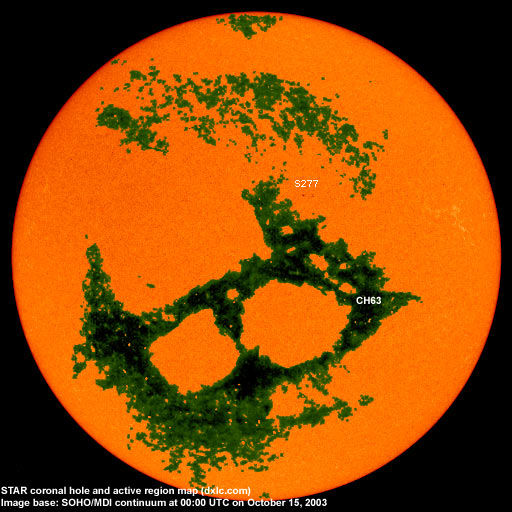

Last update issued on October 15, 2003 at 03:15 UTC.
[Solar and geomagnetic data - last month (updated daily)]
[Solar wind and electron fluence charts (updated daily)]
[Solar cycles 21-23 (last update October 4, 2003)]
[Solar cycles 1-20]
[Graphical comparison of cycles 21, 22 and 23 (last update October 4, 2003)]
[Graphical comparison of cycles 2, 10, 13, 17, 20 and 23 (last update October
4, 2003)]
[Historical solar and geomagnetic data charts 1954-2003 (last update July 23, 2003)]
[Archived reports (last update October 7, 2003)]
The geomagnetic field was unsettled to major storm on October 14. Solar wind speed ranged between 416 and 671 km/sec. The high speed stream from coronal hole CH62 was overtaken by a high speed stream from coronal hole at about 08h UTC at SOHO and ACE. This caused a considerable increase in geomagnetic disturbance levels.
Solar flux measured at 20h UTC on 2.8 GHz was 92.4. The planetary A
index was 48 (STAR Ap - based on the mean of three hour interval ap indices: 49.5).
Three hour interval K indices: 34666456 (planetary), 34544556 (Boulder).
The background x-ray flux is at the class A9-B1 level.
At midnight there was 1 spotted region on the visible disk. Solar flare activity was very low.
Regions not numbered by NOAA/SEC:
[S277] A new region emerged in the northwest quadrant a few hours after noon. Location at midnight: N20W13. Prior to
this development the visible solar disk had been spotless (for the first time since the previous solar minimum) since about 09h
UTC.
October 12-14: No potentially geoeffective CMEs observed.
Coronal hole history (since late October 2002)
Compare today's report with the situation one solar rotation ago: 28
days ago 27 days ago 26 days ago
A recurrent trans equatorial hole (CH63) will rotate into a geoeffective position on October 12-17. CH63 has become much smaller over the last rotation, losing most of its extension into the northern hemisphere.

Processed SOHO/EIT 284 image at 01:06 UTC on October 15. The darkest areas on the solar disk are likely coronal holes.
The geomagnetic field is expected to be unsettled to major storm on October 15-17 and unsettled to active on October 18-20 due to a high speed stream from coronal hole CH63.
Long distance low frequency (below 2 MHz) propagation along east-west paths over high and upper middle latitudes is useless. Propagation along north-south paths is very poor to poor [Trans Atlantic propagation conditions are currently monitored every night on 1470 kHz. Dominant station tonight: Radio Cristal del Uruguay with a fairly weak signal].
| Coronal holes (1) | Coronal mass ejections (2) | M and X class flares (3) |
1) Effects from a coronal hole could reach Earth within the next 5 days.
2) Material from a CME is likely to impact Earth within 96 hours.
3) There is a possibility of either M or X class flares within the next 48 hours.
Green: 0-20% probability, Yellow: 20-60% probability, Red: 60-100% probability.

Compare to the previous day's image.
Data for all numbered solar regions according to the Solar Region Summary provided by NOAA/SEC. Comments are my own, as is the STAR spot count (spots observed at or inside a few hours before midnight) and data for regions not numbered by SEC or where SEC has observed no spots.
| Solar region | Date numbered | SEC spot count |
STAR spot count |
Location at midnight | Area | Classification | Comment |
|---|---|---|---|---|---|---|---|
| 10475 | 2003.10.05 | S22W70 | plage | ||||
| 10477 | 2003.10.06 | 1 | S15W35 | 0010 | AXX | spotless | |
| 10478 | 2003.10.09 | N12W70 | plage | ||||
| 10479 | 2003.10.10 | 3 | N24E07 | 0010 | BXO | spotless | |
| S273 | emerged on 2003.10.08 |
N13W21 | plage | ||||
| S274 | emerged on 2003.10.09 |
N10W52 | plage | ||||
| S277 | emerged on 2003.10.14 |
6 | N20W13 | 0020 | CRO | ||
| Total spot count: | 4 | 6 | |||||
| SSN: | 24 | 16 | |||||
| Month | Average solar flux at Earth |
International sunspot number | Smoothed sunspot number |
|---|---|---|---|
| 2000.04 | 184.2 | 125.5 | 120.8 cycle 23 sunspot max. |
| 2000.07 | 202.3 | 170.1 | 119.8 |
| 2001.12 | 235.1 | 132.2 | 114.6 (-0.9) |
| 2002.09 | 175.8 | 109.6 | 94.6 (-4.1) |
| 2002.10 | 167.0 | 97.5 | 90.5 (-4.1) |
| 2002.11 | 168.7 | 95.5 | 85.2 (-5.3) |
| 2002.12 | 157.2 | 80.8 | 82.0 (-3.2) |
| 2003.01 | 144.0 | 79.7 | 80.9 (-1.1) |
| 2003.02 | 124.5 | 46.0 | 78.5 (-2.4) |
| 2003.03 | 131.4 | 61.1 | 74.1 (-4.4) |
| 2003.04 | 126.4 | 60.0 | (69.6 predicted, -4.5) |
| 2003.05 | 115.7 | 55.2 | (65.3 predicted, -4.3) |
| 2003.06 | 129.3 | 77.4 | (61.5 predicted, -3.8) |
| 2003.07 | 127.7 | 85.0 | (58.0 predicted, -3.5) |
| 2003.08 | 122.1 | 72.7 | (55.0 predicted, -3.0) |
| 2003.09 | 112.2 | 48.8 | (53.0 predicted, -2.0) |
| 2003.10 | 111.5 (1) | 33.6 (2) | (50.3 predicted, -2.7) |
1) Running average based on the daily 20:00 UTC observed solar flux value at 2800 MHz.
2) Unofficial, accumulated value based on the Boulder (NOAA/SEC) sunspot number. The official international sunspot number is typically
30-50% less.
This report has been prepared by Jan Alvestad. It is based partly on my own observations and analysis, and partly on data from sources noted in solar links. All time references are to the UTC day. Comments and suggestions are always welcome.
| [DX-Listeners' Club] |